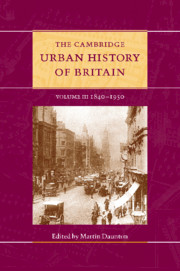Book contents
- Frontmatter
- 1 Introduction
- Part I Circulation
- 2 Urban networks
- 3 Modern London
- 4 Ports
- 5 The development of small towns in Britain
- 6 Migration
- 7 Pollution in the city
- 8 From Shillibeer to Buchanan: transport and the urban environment
- Part II Governance
- Part III Construction
- Part IV Getting and spending
- Part V Images
- Select bibliography
- Index
- Plates 1-7
- Plates 8-14
- Plates 15-20
- Plates 21-27
- Plates 28-34
- Plates 35-41
- Plates 42-48>
- Plates 49-53
- References
8 - From Shillibeer to Buchanan: transport and the urban environment
from Part I - Circulation
Published online by Cambridge University Press: 28 March 2008
- Frontmatter
- 1 Introduction
- Part I Circulation
- 2 Urban networks
- 3 Modern London
- 4 Ports
- 5 The development of small towns in Britain
- 6 Migration
- 7 Pollution in the city
- 8 From Shillibeer to Buchanan: transport and the urban environment
- Part II Governance
- Part III Construction
- Part IV Getting and spending
- Part V Images
- Select bibliography
- Index
- Plates 1-7
- Plates 8-14
- Plates 15-20
- Plates 21-27
- Plates 28-34
- Plates 35-41
- Plates 42-48>
- Plates 49-53
- References
Summary
This chapter looks at the interaction between changes in methods of transport and the growth of the urban environment. It takes essentially a functional approach, explaining in what ways developments in transport enabled towns and cities to grow in size, scale and function and hence the roles which transport systems played in these urban centres. In addition it looks at transport as a network of which cities were the nodal points and where the lines were often symbolic as well as physical boundaries. Finally it examines the growth of transport facilities as specific loci within the city.
THE COMPACT CITY
In early Victorian Britain most towns and cities were small by subsequent standards, although to contemporaries they seemed gross and overblown. London was out of all proportion to the rest of the country with its population in 1851 of 2.7 million and its geographical extent, including both the City and West End, of about 20 square miles (51.8 square km). Most towns were small in size, for instance Manchester in the 1840s was only about 1 mile square (2.59 square km) with a population of 300,000 and other urban centres were rarely much larger. The most common method of moving about these cities was by foot. Pedestrians dominated the traffic, not just walking to work, but carrying baskets or packs of goods, pushing barrows and hand carts and leading donkeys, horse-drawn carts and waggons. Most people lived close to their places of occupation.
Keywords
- Type
- Chapter
- Information
- The Cambridge Urban History of Britain , pp. 229 - 258Publisher: Cambridge University PressPrint publication year: 2001
References
- 1
- Cited by



